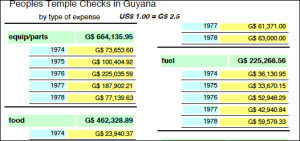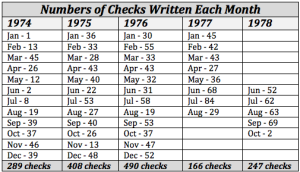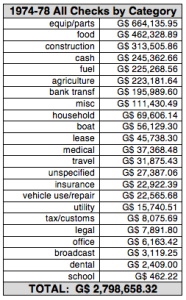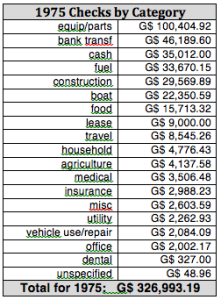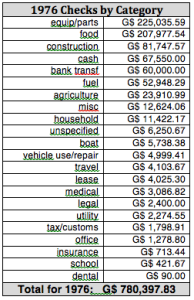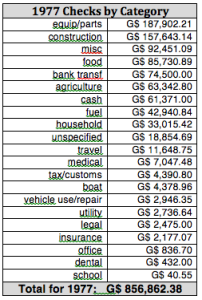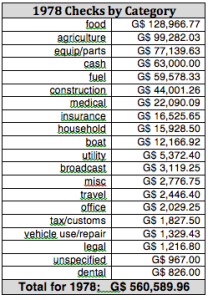From 1974 to 1978, Peoples Temple built an agricultural mission on a leasehold in the North West District of Guyana. Over that time more than 1000 people moved to Guyana, most living in Jonestown and some living in a house in Georgetown. Though much was made of the millions of dollars Peoples Temple tucked away in various international bank accounts that was tracked down afterwards, the actual expenditures in Guyana in those four and a half years has never been tallied.
Materials released by the FBI under FOIA contain financial records for that period that include: bank account deposit and transfer slips, canceled checks, check-book registers, and handwritten records of cash expenditures. These were part of 11 trunks worth of papers gathered from Jonestown and Georgetown by the FBI following the murders of November 18, 1978. If expenditures shown by these checks are compiled, an overview of Temple expenditures in Guyana can be shown.
Temple Monies in Guyana
The Guyana materials indicate there were three checking accounts, used at various times: (1) Barclays, (2) Bank of Canada and (3) Guyana National Cooperative Bank. Checks required two signatures to be cashed. One signee was often in Jonestown, with the second signee in Georgetown (where purchases were made). Often checks had one signature already filled in, and the second one was added as purchases or payments were approved and made.
Approximately 2000+ checks have been found in the FOIA materials (of which about 400 were VOID, cancelled or unused). These have all been put into a database to organize and examine Temple spending in Guyana. Checks were tagged into 23 categories. The tables here and pdf files were created summarizing how much was spent overall and in each year, for each category.
For list of all checks (sample below) download PT Check Register.pdf [6.1MB]
For yearly totals by category (sample below), download PT Checks by Type.pdf
For monthly totals by category (sample below), download PT Checks by Month.pdf
In addition to checking accounts for expenses, receipts indicate there was much being done with monies moving from the states, being placed in various types of money-earning accounts, in Georgetown and other countries. Much was done to maximize earnings and make sure resources were not in only “one basket.”
Jim Jones had often said to diversify monies so no one person or bank knew all our finances; hence three checking accounts. It was also a way to establish economic presence across all the various powers in Guyana. He was always very “tight” with money, having to approve all major and most minor purchases as well. This study does not examine activities other than the checking accounts.
Problems in Compiling the Checking Information
Sources: (a)
Checks were found in seven sections of the FBI FOIA materials of RYMUR 89-4286-2018:
A-1 Financial;
A-2 Financial;
A-3 Financial;
A-4 Financial;
A-5 Financial;
A-13 Financial;
A-18 Financial.
(b) Expense records were found at RYMUR 89-4286-2018- Section A-25; this includes expense records of check “cash advances” that were not examined.
Various problems were encountered in compiling Temple expenditures from the checks available. How these were handled is described below.
1. Not all checks indicated what was purchased. Some information came from cashed checks, which did not indicate what was being paid for; other information came from check registers which usually had notations of what was purchased.
2. Not all checks found had been used. There were many VOIDed, cancelled and unused checks.
3. Some copies of the checks were hard to read. Most often this was due to poor handwriting. To a far lesser extent, poor copying made for difficult reading.
4. For checks with no indication of what was purchased, the payee often made the category clear. Because some stores sold only one type of product (Shell [fuels], GUYTRAC [equipment], BATA [shoes], etc.) the category was clear. For checks to general merchandise stores (Bookers, Santos), unlisted categories couldn’t be known. For these stores, using the known purchases, categories were assigned according to the profile the known purchases at these stores indicated (as, 20% food, 40% equipment/parts). For some checks where no prediction could be made, a category of “unspecified” was assigned.
5. Many checks were indicated as “cash” to Temple members (amounts from G$ 100 to G$ 10,000 to Paula Adams, Charles Touchette, Deborah Touchette, etc). These seem to have been for prospective cash purchases in Georgetown. People had to keep detailed records of expenses from a cash advance with unspent monies returned. Many of these expense records can be found in section A-25, which — though probably incomplete — covers a wide range of dates. These “records of expenses” were not examined here.
6. The accounts: (1) The Barclays checking account was in use from January 1974 through November 1978. (2) Guyana National Coop Bank checks appear in 1976. (3) Bank of Canada checking account began in December 1975 and closed in August 1977 (indicated by a note at end of the check register ending at that period).
7. Some months had no checks (above) found. The chart shows a count of cashed checks, about 1600; it does not include the 400+ VOIDs, etc.. The months with “no checks found” (September 1977 to May 1978) seem to correspond to the arrival and accommodation to a population of 1000 people as a formal structure was set up to run Jonestown by summer of 1978. Though it is likely that checks were written from July 1977 to June 1978, why they are missing is unknown. Were the checks misplaced in the confusion of organizing Jonestown? Were they just not found by the FBI? Or, as with other materials, were they held aside by the FBI? Materials found so far don’t give any indication.
8. Expenditures that didn’t come from the checking accounts are not included here. As there were multiple money accounts in or near Guyana (indicated by many receipts for deposits and transfers), monies could easily have been spent with no record in checking accounts.
Observations of Expenditures Shown by Checks
For five-year and annual summaries, download PT Checks.pdf
Overall expenditures shown by checks confirm that monies were spent on building and sustaining the Agricultural Mission settlement in Jonestown. Over four and a half years, checks show expenditures in Guyana of G$ 2.8 million (about US$ 1.2 million).
In public Jim Jones claimed to have spent much more, though an accounting was never given in public or to the Planning Commission. He may have been including all that was spent in the states in preparation: buying and shipping items from the states; buying the trawler Cudjoe and eventually the ship Albatross; two charter flights to Georgetown from LA; moving people from California to Guyana, etc. How much more this added, has not been estimated here. The checks indicate expenditures for only what was being spent in Guyana.
Below are summaries of expenditures from checks by categories — overall and for each year.
Overall:
-
- 1. Most was spent (in order) on
(1) equipment/parts
(2) food
(3) construction
(4) fuel
(5) agriculture
2. Least spent in Guyana was on school. This seems a surprise, but school “supplies” had been sent from the states.
3. About 1% of expenses were “unspecified.” Checks to unfamiliar vendors with no indication of what was purchased were classified as “unspecified.” Some of these purchases were categorized by checking the internet, for vendors that still exist.
4. The exchange rate fluctuated around US$ 1.00 = G$ 2.50. This was determined from various deposit slips for US dollar deposits in the FOIA materials.
5. Checks to “cash” or to Temple members as a cash advance (Paula Adams, Charles Touchette, Deborah Touchette, etc) was the fourth largest category with G$ 245,000 overall. Each person who received cash had to account for their expenses, listing purchases and including receipts. Section A-25 of the FOIA materials contains many pages of handwritten “cash” records itemizing expenses — though G$ 5,000 and G$ 10,000 was hardly petty cash. Many purchases of equipment and services were made on a cash basis. Analysis of “petty cash” records could distribute much of this “cash” to other categories. There were many allegations of Guyanese officials being paid for influence; that any of this “cash” was used in donations to individuals probably would not be recorded.
6. “Misc” includes such expenses as: PR, donations, dues, freight, radio & antenna, movies. Also there were checks for a hand gun and ammunition (12/30/1975) and shotgun ammunition (6/16/1978).
7. “Utility” referred to expenses of the house in Georgetown: electricity, rent, telephone, etc.
In 1974, most expenses reflected getting underway in carving out a place to live from virgin jungle: securing a lease and survey, first work in carving a road and clearing land, first agriculture efforts, buying equipment to work the land and begin constructing buildings.
In Georgetown, this year of getting underway included equipment purchasing, working with Guyanese officials, securing a house and transportation.
The Cudjoe arrived in August with the first “settlers” who lived in Port Kaituma until the first building was ready at the start of 1975. From then on, the boat served to bring people and items from Georgetown to Port Kaituma for Jonestown. As well, its tanks were always filled with fuel in Georgetown to bring to Jonestown.
In December a chartered plane from LA brought most of the Planning Commission to visit, as well as several more settlers and Mr. Muggs to remain in Guyana.
In 1975, equipment, construction, the boat, and fuel were major expenses. Settling the lease was still underway. Money transfers are reflected, setting up checking, savings and other accounts.
The first buildings were finished and the “settlers” moved into Jonestown from Port Kaituma at the beginning of the year.
Large checks to Joyce Touchette were for monies to Jonestown to pay the local crew of agricultural workers hired to clear the initial acreage and get agricultural operations underway. This continued into 1976.
Land clearing was continued, using our dozers; the road in was to be cleared on each side and planted. Raising of chickens was underway; with plans for other animals planned.
In December a charter plane brought paying congregation members to visit the project.
In 1976, expenses doubled. Equipment, food, construction, fuel and agriculture were highest. Planning for more inhabitants was underway.
Clearing land and the road continued. Chicken production was expanded. The barns and animal pens — for pigs, cattle and horses — were built next to the chicken sheds in a cleared area along the road a mile out from the main living area. By year end pigs and cattle were brought in.
Food and household expenses reflected stockpiling food and furnishings for buildings as they were built.
An electrical system (poles, cable, generators, accessories, etc.) was built for all of Jonestown in the spring.
With some 20 children in Jonestown, Tom Grubbs went to Guyana in June to set up and run a school program for them, which was then expanded in 1977 with the influx of people from the states.
Construction was undertaken of the five large apartment dorms and the 50 cottages. Tent structures were adapted to house school classes.
In 1977, checks were found for January to August only, meaning details for a third of the year are missing. For what was found, expenses continued high — construction doubled again, as preparations for Jonestown growth expanded.
In July, the mass migration of Temple members to Guyana was begun, when Jim Jones emigrated to Jonestown. Peoples Temple in Guyana grew from 100 in July to 800 by December. The sudden growth would have involved much work and expense in processing the new arrivals in Georgetown, transporting them to Jonestown, absorbing them into Jonestown and providing for their needs.
“Misc” includes checks to buy our house in Lamaha Gardens in Georgetown; eventually people would come and go, with 30+ people there at any one time for various appointments and activities: initial immigration, medical, dental, performing, etc.
Tax and customs related to shipments of materials from San Francisco.
In 1978, checks were found for May to September only, meaning details for half the year (five of eleven months) are missing. With a full population, expenditures should have risen dramatically, not declined, from 1977. More checks would show more.
Much was said about lack of food and balanced diet. And certainly more money could have been spent in light of all the monies sequestered; yet the largest expense in recovered checks was for food.
Checks for these five months also indicate:
(1) Dental and medical expenses were much higher than previous years, including flying people to Georgetown, Caracas or Maracaibo for treatment.
(2) For the first time, Temple programs were being broadcast in Georgetown.
(3) Under Marcie’s direction in the summer, much effort and construction was made to improve the appearance and comfort in and around the buildings of Jonestown: wood walkways, wood railings, flowers, plantings, paint and more.
(4) “Cash” checks continued high, even with missing months, probably for expenses to defend the Temple and outfit our new ship, the Albatross, for its October launch into commercial transport.
(5) Agriculture expenditures were high, continuing more long range planning shown in the FOIA materials [See Agriculture & Livestock on the Jonestown Research page.]
A Request
By following the checks and analyzing the expenditures we get an insight into the running of Peoples Temple and of the vast amount of the resources that was required to keep an operation of this size and scope going. More observations and suggestions are needed. Please check out these files for yourself and share any observations or questions you may have.
(Don Beck was a member of Peoples Temple for ten years. He directed the Peoples Temple children’s choir during its Redwood Valley years and made several trips to Guyana during its pioneer days. Beginning about 20 years after the tragedy, shortly after this site went online, he became one of its most dedicated researchers, transcribing Edith Roller journals, reviewing and analyzing Jonestown records released through the Freedom of Information Act, and compiling them for the first section of documents on the Jonestown Research page. He also contributed numerous articles and remembrances. Most of those writings may be found here.)
(Don died on July 9, 2021, following a lengthy illness. He was 78.)

